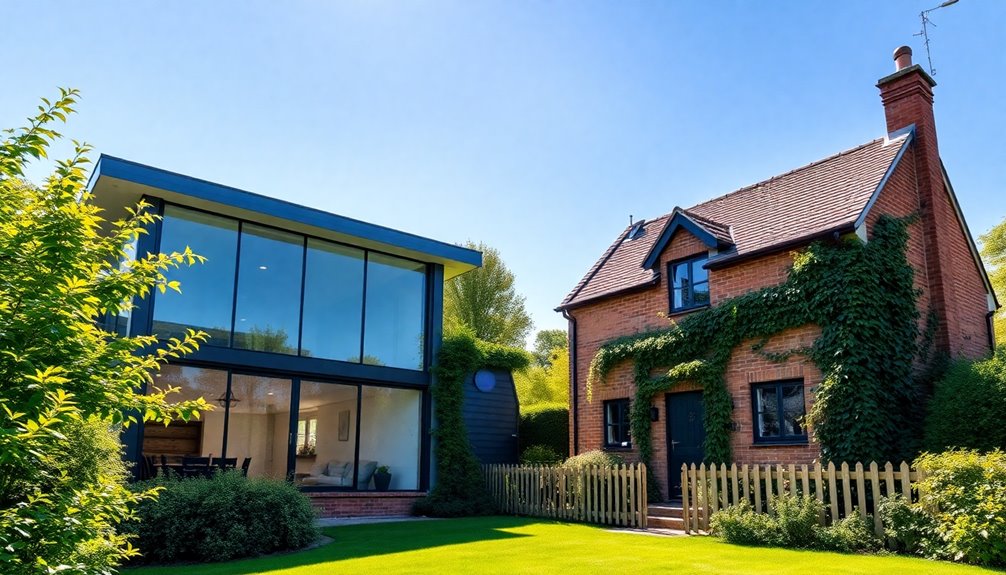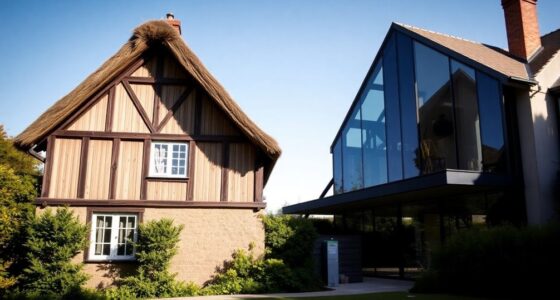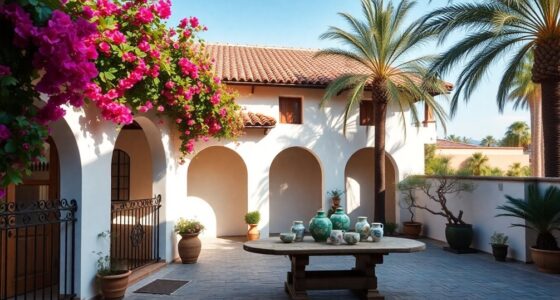When you compare modern and traditional houses, you'll notice key differences in design and materials. Traditional homes highlight intricate craftsmanship, using stone and wood for warmth, while modern designs embrace minimalism, featuring steel, concrete, and glass. Space utilization differs, too; traditional houses have segmented areas, creating cozy vibes, whereas modern homes favor open floor plans that maximize natural light. Aesthetics also set them apart—traditional styles boast ornate details, while modern designs lean toward clean, simple lines. Understanding these contrasts can deepen your appreciation for architectural choices and their impact on your living space. There's much more to explore if you want!
Key Takeaways
- Traditional houses feature ornate details and segmented spaces, while modern houses emphasize minimalism and open floor plans for a spacious feel.
- Modern architecture utilizes industrial materials like steel and glass, whereas traditional homes often incorporate warm, natural materials like wood and stone.
- Traditional kitchens showcase dark wood and vintage fixtures, while modern kitchens focus on sleek lines and stainless steel appliances for a contemporary look.
- Aesthetic differences include traditional homes favoring rich colors and textures, while modern designs embrace neutral tones and smooth surfaces.
- Traditional architecture strengthens community identity through cultural significance, while modern designs promote social interaction with seamless indoor-outdoor transitions.
Definitions of Traditional Architecture
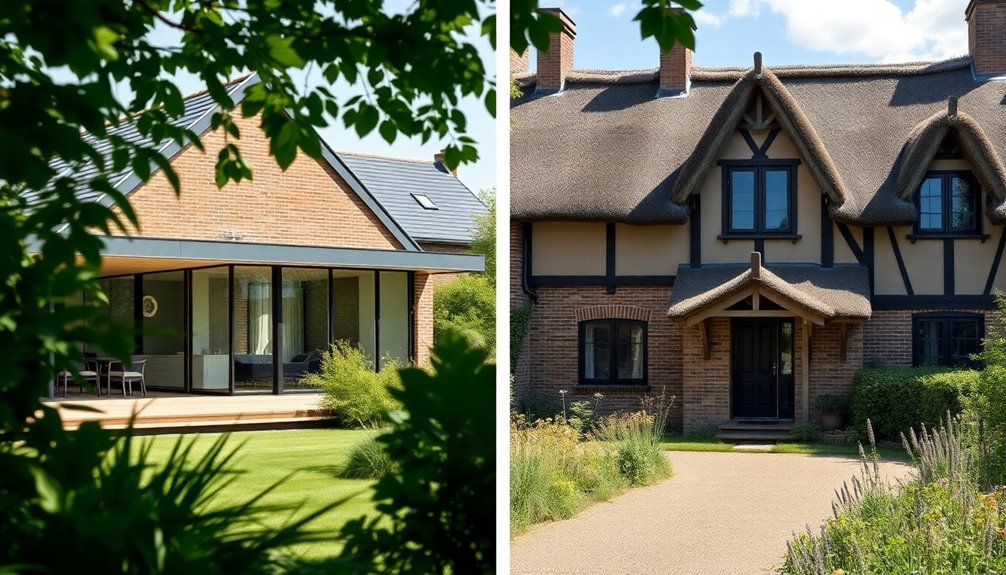
When you think of traditional architecture, you're likely envisioning homes that reflect rich historical styles and cultural elements.
Traditional architecture encompasses historical house structures showcasing craftsmanship, with intricate woodwork and ornate moldings that tell a story of the past.
These homes often feature segmented spaces, designed for specific purposes, creating cozy and intimate atmospheres through single-purpose rooms.
Common materials, like durable woods such as oak, pine, and cedar, along with natural stone, enhance the warm aesthetic you associate with these styles.
A key aspect is symmetry and proportion, evident in gabled roofs and dormer windows, which contribute to the balanced and visually appealing facades of traditional homes.
This harmony connects you to a rich architectural heritage.
Characteristics of Modern Architecture
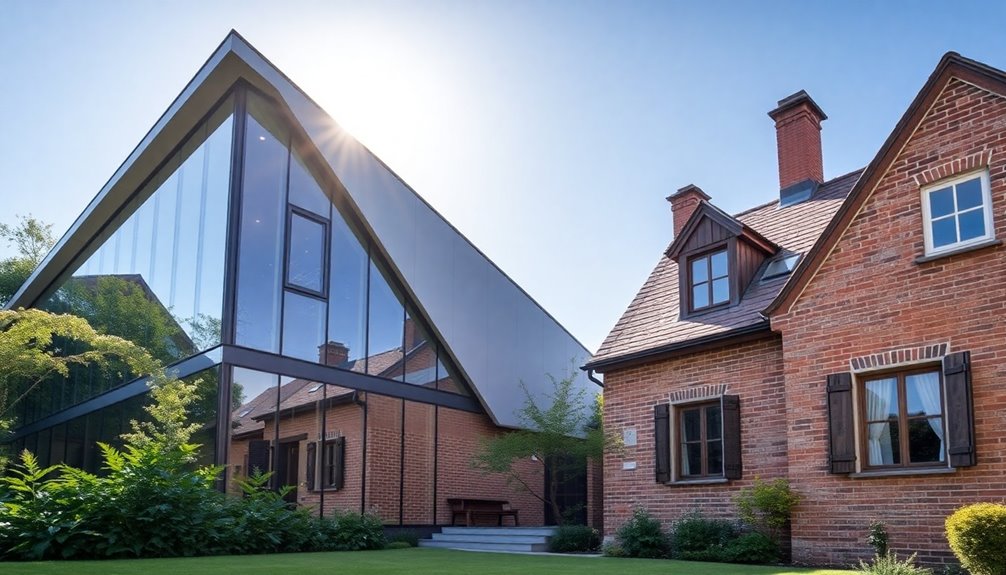
While traditional architecture showcases historical craftsmanship and cozy, segmented spaces, modern architecture shifts the focus to minimalism and functionality. It emphasizes clean lines and simple forms, prioritizing practicality over excessive ornamentation.
You'll notice large windows and open floor plans designed to maximize natural light while fostering a seamless connection between indoor and outdoor spaces. Common materials like steel, concrete, and architectural glass not only enhance the streamlined aesthetic but also guarantee structural integrity.
Emerging in the 1920s, modern architecture reflects technological advancements and a cultural shift towards contemporary living. Additionally, sustainability is vital; modern homes frequently utilize sustainable materials and energy-efficient systems, reducing environmental impact while maintaining a stylish, minimalist appeal. Many designers also incorporate local craftsmanship into their projects, emphasizing the importance of authenticity in modern home designs.
Space Utilization in Homes
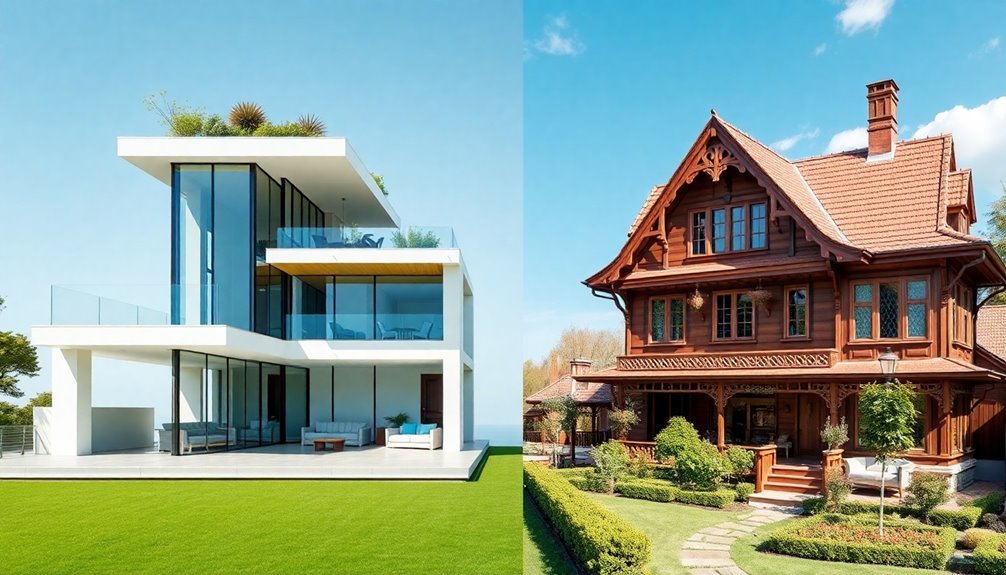
Space utilization in homes varies markedly between traditional and modern designs, reflecting differing priorities in lifestyle and functionality.
Here's how they differ:
- Defined Areas vs. Open Floor Plans: Traditional homes feature segmented spaces for specific purposes, while modern homes prioritize open floor plans that encourage interaction and movement.
- Natural Light: Modern homes often incorporate large windows and skylights to maximize natural light, creating a bright, airy feel, unlike traditional homes that rely on decorative elements.
- Multifunctional Spaces vs. Privacy Concerns: Modern designs create flexible, multifunctional spaces, but this can raise privacy concerns due to the lack of separation, requiring thoughtful planning to maintain personal boundaries in shared areas.
Aesthetic Differences Between Styles
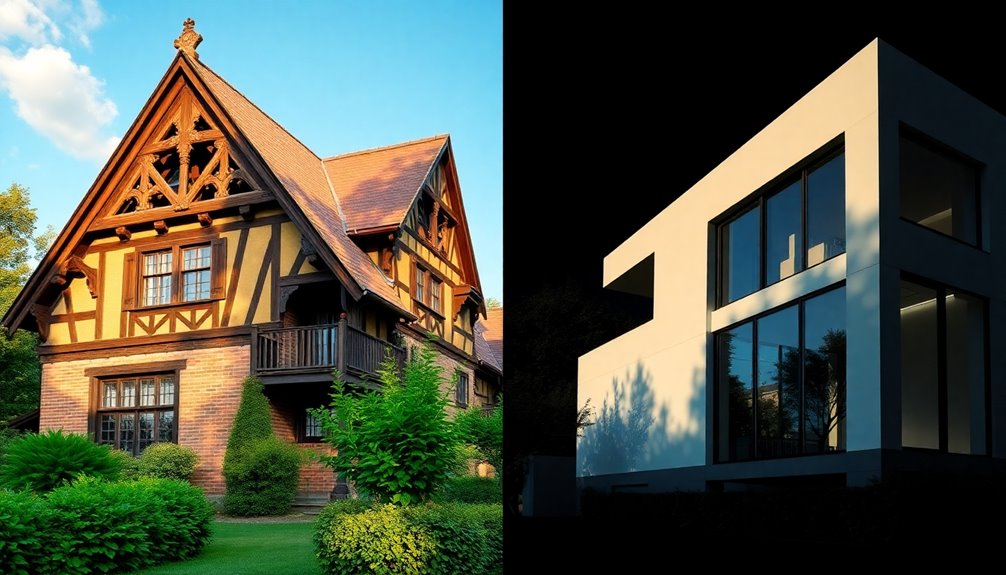
When you compare traditional and modern houses, you'll notice striking differences in textures and patterns.
Traditional homes boast ornate details and rich materials, while modern designs favor a minimalist approach that emphasizes clean lines and simplicity.
Additionally, the color schemes and materials reflect these styles, with traditional homes featuring darker hues and modern ones embracing neutral tones for a fresh feel.
Textures and Patterns
Textures and patterns play an essential role in defining the aesthetic differences between modern and traditional houses.
In traditional homes, you'll find rich textures and ornate woodwork that evoke warmth and history. A mix of intricate patterns, like floral and geometric designs, adorns wallpapers and upholstery.
In contrast, modern homes embrace minimalism with smooth surfaces and clean lines, emphasizing simplicity.
Here are three key distinctions:
- Traditional Homes: Rich textures, heavy materials, and detailed craftsmanship.
- Modern Homes: Sleek, lightweight furniture often combines metal and glass, focusing on functionality.
- Color Palettes: Traditional styles use vibrant hues, while modern interiors prefer neutral color palettes with bold accent pieces, minimizing decorative elements.
Symmetry vs. Minimalism
While traditional houses often showcase symmetry as a defining characteristic, modern homes lean towards minimalism that challenges conventional designs. Traditional architecture emphasizes balance and proportion with ornate craftsmanship, featuring classical elements like columns and gabled roofs. In contrast, modern design prioritizes function over form, showcasing clean lines and asymmetrical shapes. The evolution of these styles also reflects changes in interior design preferences as society adapts to new lifestyles.
| Traditional Houses | Modern Homes |
|---|---|
| Symmetrical designs | Asymmetrical shapes |
| Ornate craftsmanship | Minimalist aesthetics |
| Rich textures, colors | Neutral color palette |
| Cultural identity focus | Reflects contemporary lifestyle |
These aesthetic differences highlight a shift from the historical essence of traditional homes to a streamlined approach in modern architecture, reflecting evolving tastes and lifestyles.
Color Schemes and Materials
Color schemes and materials play a crucial role in distinguishing traditional houses from modern homes. Traditional design elements often showcase rich textured fabrics and jewel tones, creating warmth and character.
In contrast, modern architectural styles lean toward neutral colors and minimalistic designs, emphasizing a clean aesthetic.
Here are three key differences:
- Color Palette: Traditional homes feature bold, dark colors, while modern designs favor lighter, monochromatic schemes.
- Building Materials: Traditional houses use natural materials like wood and stone, whereas modern homes incorporate industrial materials like steel and glass.
- Decorative Elements: Traditional architecture boasts intricate patterns and symmetry, while modern styles embrace asymmetry and functional simplicity, creating a striking visual impact.
Additionally, modern designs often integrate eco-friendly materials to promote sustainability and reduce environmental impact.
Material Choices in Construction

When it comes to material choices in construction, the differences between modern and traditional houses are striking.
Traditional houses often showcase brick, wood, stone, and stucco, emphasizing warmth and historical significance. Their craftsmanship features intricate woodwork, reflecting local artisanship.
In contrast, modern houses prioritize durability with industrial materials like steel, concrete, and glass, achieving a sleek aesthetic. You'll notice that modern designs lean towards neutral color schemes, promoting a clean, minimalist look.
Additionally, modern construction frequently incorporates eco-friendly materials, enhancing energy efficiency and sustainability—elements that traditional building practices don't emphasize as much.
Ultimately, your choice of a home may depend on whether you value the cozy charm of traditional craftsmanship or the innovative, functional approach of modern materials.
Kitchen Design Variations
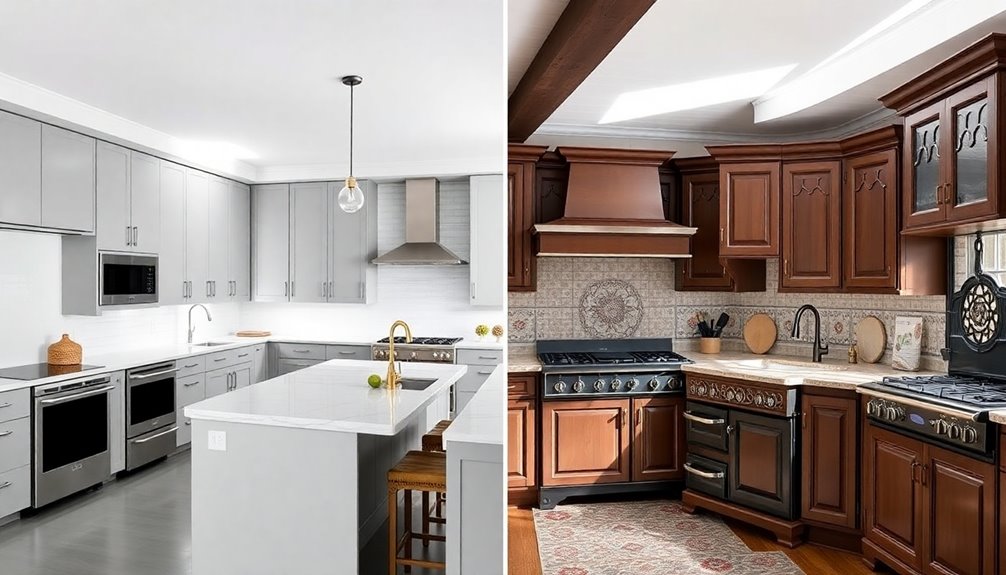
The differences in material choices naturally extend to kitchen design, highlighting the distinct characteristics of traditional and modern homes.
You'll notice several kitchen design variations:
- Traditional Kitchens: These often feature ornate moldings, glass-front cabinets, and warm materials like dark-stained wood, creating a cozy atmosphere. Decorative elements such as intricate tile backsplashes and vintage fixtures are common.
- Modern Kitchens: Prioritizing clean lines and functionality, modern kitchens use stainless steel appliances and bold neutral colors for a sleek look. They often embrace open-concept layouts that promote social interaction.
- Materials: Traditional kitchens reflect craftsmanship with solid wood cabinetry, while modern kitchens leverage innovative materials for durability and ease of maintenance. The use of natural materials such as wood and metal in modern designs enhances both aesthetics and functionality.
Understanding these differences can help you choose the right style for your home.
Furniture Styles and Arrangements

When you think about furniture styles, traditional pieces often feature rich woods and ornate designs that create a cozy, formal atmosphere.
In contrast, modern furniture trends highlight sleek lines and minimalist forms, promoting flexibility and open spaces.
Understanding these differences can help you choose the right style for your home.
Traditional Furniture Characteristics
Traditional furniture embodies a timeless elegance that reflects craftsmanship and attention to detail.
You'll notice features like ornate designs and heavy materials, creating a rich aesthetic in your space.
Here are three key characteristics of traditional furniture:
- Styles: Common styles include Chippendale, Queen Anne, and Victorian, each with unique elements like cabriole legs and upholstered seats.
- Arrangement: Pieces are arranged to emphasize symmetry and balance, often creating a formal atmosphere with matching pairs of chairs or sofas.
- Textures and Colors: Expect rich textures and jewel tones, enhancing warmth and inviting ambiance in your living spaces.
Modern Furniture Trends
As you explore the world of interior design, you'll notice a striking contrast between traditional and modern furniture trends. Modern furniture emphasizes minimalist designs that prioritize functionality and simplicity. You'll find clean lines and geometric shapes dominating the landscape, often crafted from durable materials like metal and glass.
Modern arrangements favor open spaces, allowing you to create flexible layouts perfect for various activities. Color palettes typically consist of neutral tones, accented with pops of bold colors for balance. Multi-functional pieces, such as convertible sofas and nesting tables, are essential for maximizing space in smaller homes. Additionally, the rising popularity of tiny house living reflects a broader societal shift towards minimalism and efficient use of space.
| Feature | Modern Furniture |
|---|---|
| Design | Minimalist, Clean Lines |
| Materials | Durable, Eco-Friendly |
| Arrangement | Open Spaces, Flexible |
Lighting and Window Features
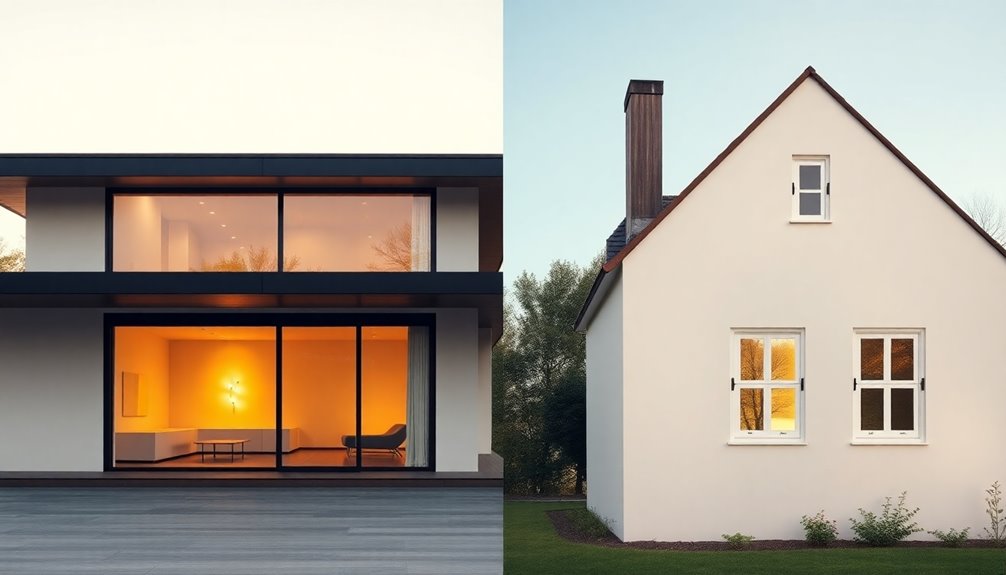
While both modern and traditional houses prioritize natural light, they achieve this in distinctly different ways.
- Window Features: Modern homes boast large, unadorned windows and skylights, creating a seamless indoor-outdoor connection, while traditional houses often utilize smaller panes with intricate woodwork and decorative elements like stained glass.
- Lighting Styles: Modern lighting leans towards recessed fixtures and sleek designs, keeping spaces clutter-free, whereas traditional homes feature elaborate chandeliers and decorative lamps that add warmth.
- Energy Efficiency: Modern architecture focuses on energy-efficient windows to reduce heat loss, contributing to sustainability, while traditional houses emphasize aesthetic appeal over energy efficiency.
Cultural Significance of Designs
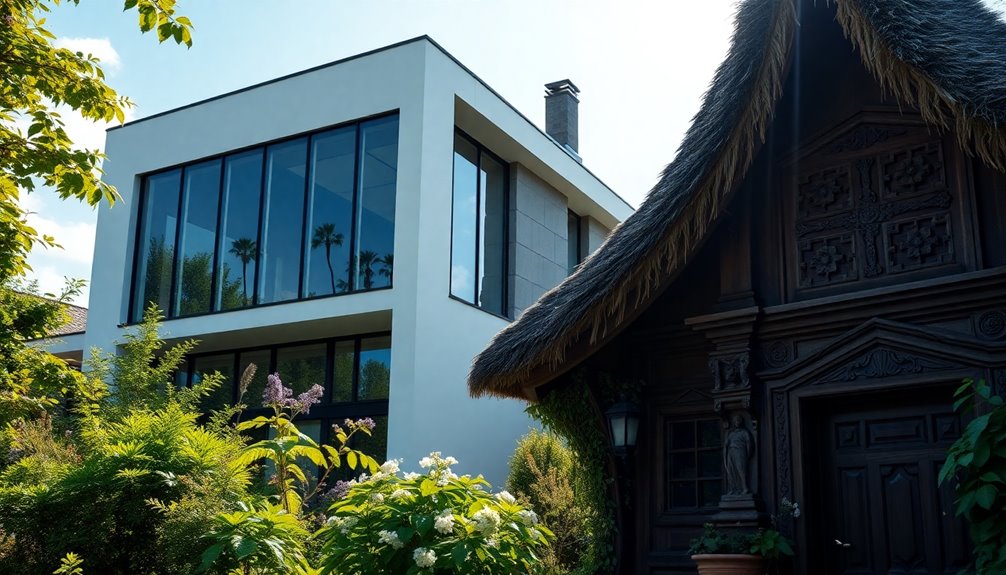
When you look at traditional houses, you see a strong connection to historical heritage and community identity.
Each design element tells a story that links you to your ancestors and local customs.
In contrast, modern homes focus more on innovation and sustainability, reflecting today's values and lifestyle choices.
Historical Heritage Preservation
Preserving historical heritage in architecture not only honors past generations but also enriches our present and future.
Traditional architecture embodies cultural significance and community identity, fostering a sense of place. Here are three key benefits of preservation efforts:
- Architectural Integrity: Keeping traditional designs intact maintains the craftsmanship and artistry of earlier periods, allowing you to appreciate unique regional styles like Victorian or Colonial.
- Cultural Continuity: By preserving these structures, you guarantee future generations understand their roots, highlighting the importance of local history.
- Locally Sourced Materials: Traditional homes often use materials that reflect the environmental characteristics of their regions, reinforcing a deep connection to the land.
Incorporating innovative interpretations of these designs can bridge past and present, enriching our architectural landscape. Additionally, preserving these homes can serve as a hedge against economic downturns, demonstrating their value in maintaining community stability.
Community Connection and Identity
Traditional architecture plays an essential role in shaping community connection and identity, as it often embodies the unique cultural narratives and craftsmanship of a region. By using local materials, these homes reinforce a sense of belonging, showcasing the area's resources and history.
In contrast, modern homes tend to prioritize minimalism and functionality, sometimes sacrificing the cultural nuances that enrich community identity. While they may incorporate smart technology to align with contemporary lifestyles, they often lack the deep-rooted connections found in traditional designs.
Additionally, traditional homes frequently feature communal areas like courtyards, fostering social interactions and strengthening relationships within the community. This blend of heritage and communal space creates a vibrant identity that modern architecture may struggle to replicate.
Challenges in Home Design
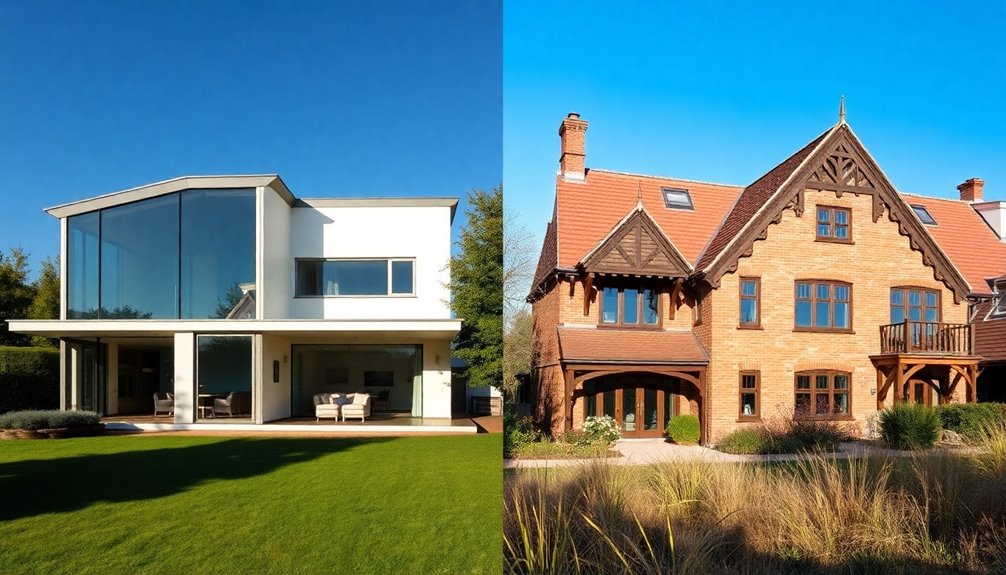
Designing a home always comes with its unique set of challenges, whether you're leaning towards a modern or traditional style. Here are some key issues you might face:
- Cohesive Design: Traditional homes often require careful decorating to avoid visual clutter, especially with ornate features.
- Privacy vs. Openness: Modern open floor plans can compromise privacy, making it hard to find secluded spaces.
- Maintenance and Costs: While modern homes typically need less upkeep, structural changes to create open layouts can be costly. Additionally, ensuring proper venting requirements for any heating solutions can also add to maintenance considerations.
Navigating these challenges can help you create a space that meets your needs while balancing the aesthetic qualities of your chosen style.
Whether you favor the charm of traditional homes or the sleekness of modern designs, understanding these hurdles is essential.
Frequently Asked Questions
What Is the Difference Between Old House and Modern House?
When you think about the difference between an old house and a modern house, consider their design and materials.
Old houses often feature defined rooms and traditional craftsmanship with materials like wood and brick.
In contrast, modern houses emphasize open spaces and sleek materials, such as steel and glass.
You'll notice modern homes also prioritize large windows for natural light, while older homes may rely more on decorative elements for ambiance.
What Is the Difference Between Modern and Traditional?
When you think about the difference between modern and traditional, consider their design philosophies.
Modern styles focus on minimalism and open spaces, encouraging a fluid lifestyle, while traditional designs emphasize segmented areas and historical styles.
You'll notice material contrasts too—modern homes often use glass and steel, whereas traditional ones favor wood and stone.
Additionally, modern architecture maximizes natural light with large windows, while traditional homes tend to have smaller, more compartmentalized spaces.
What Is the Difference Between Traditional and Modern Buildings?
When you wander through the architectural landscape, traditional buildings stand like grand storytellers, their intricate details whispering history.
In contrast, modern buildings rise boldly, embracing open space and minimalism. You'll notice traditional ones use warm woods and sturdy stones, while modern designs flaunt sleek steel and expansive glass.
As you explore, observe how light floods modern interiors, while traditional spaces hold onto cozy nooks, each style reflecting its own unique rhythm and purpose.
What Is the Difference Between Old House and New House?
When you compare old houses to new ones, you'll notice distinct differences.
Old houses often feature intricate designs, smaller windows, and compartmentalized rooms, creating a cozy atmosphere.
In contrast, new houses emphasize open floor plans, large windows, and modern materials like steel.
While old homes showcase craftsmanship and historical charm, new constructions prioritize energy efficiency and technological advances.
Ultimately, your choice reflects your lifestyle preferences and values regarding space and design.
Conclusion
In comparing modern and traditional houses, it's clear that each style offers unique advantages and charm. Did you know that over 70% of homebuyers today prefer open floor plans, a hallmark of modern architecture? This desire for space reflects a shift in lifestyle and priorities. While traditional homes often emphasize heritage and craftsmanship, modern designs embrace minimalism and functionality. Ultimately, your choice depends on personal taste and how you envision living in your space.
